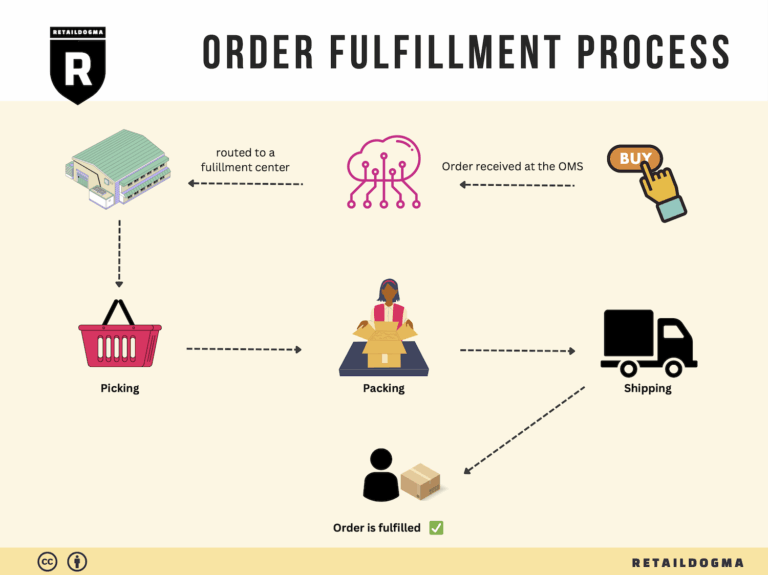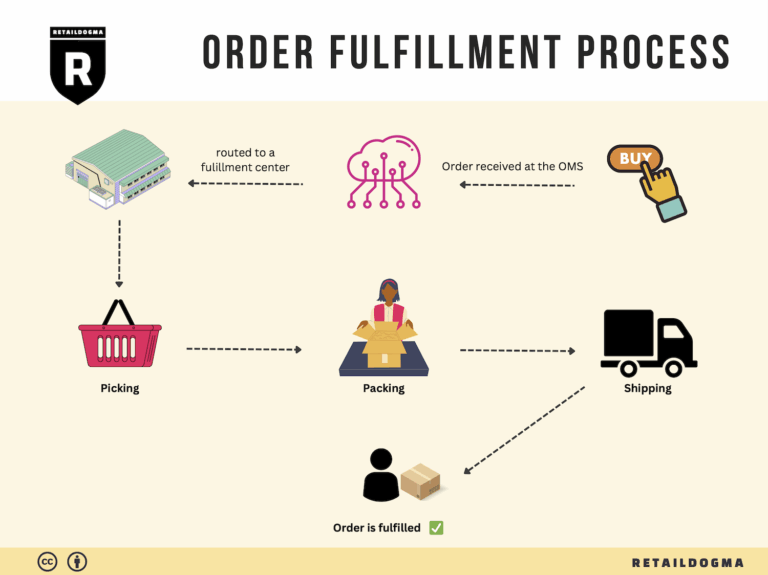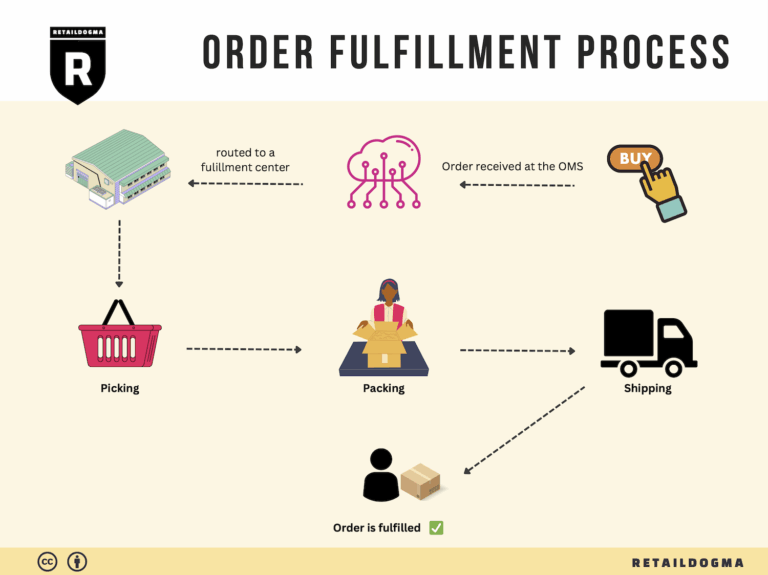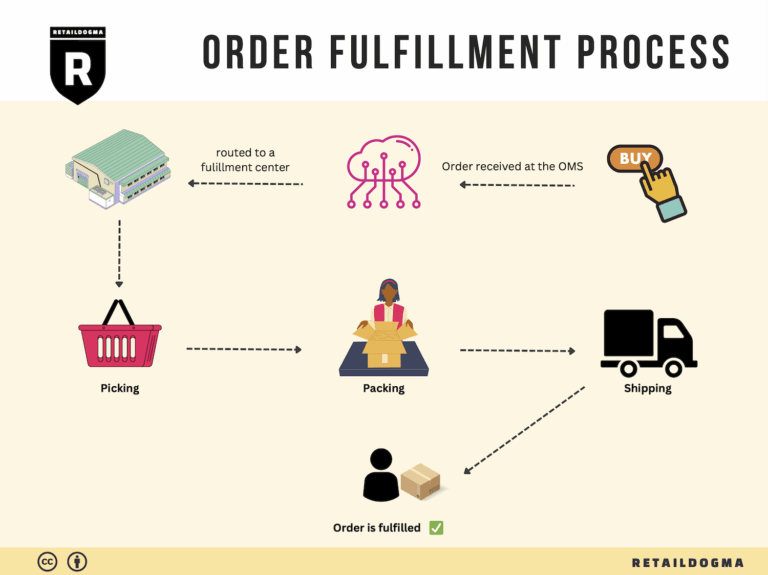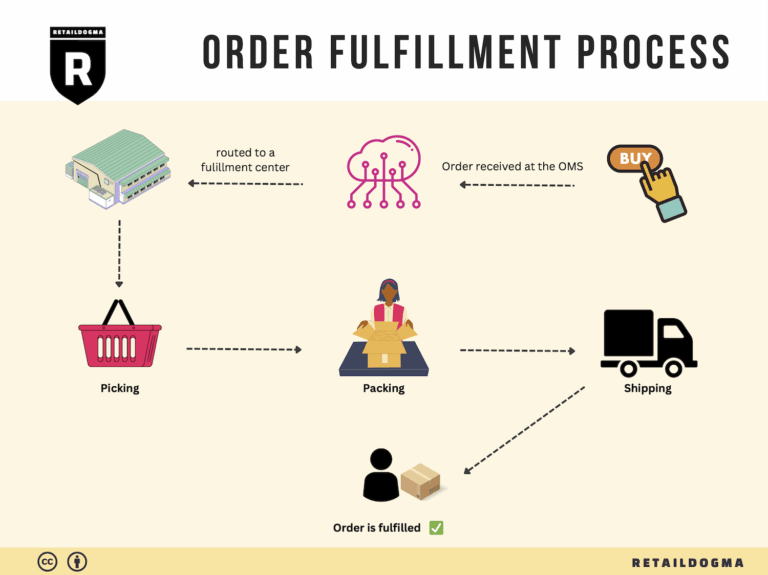Ecommerce Fulfillment Services: The Ultimate Guide (2025)
What is E-commerce Fulfillment? An Introduction for Growing Businesses
As e-commerce business owners, you know that the excitement of attracting customers can quickly turn into the stress of managing orders, especially when it comes to packing and shipping. The logistical challenges of fulfilling orders can feel overwhelming, leading to delays, errors, and dissatisfied customers. This is where understanding e-commerce fulfillment becomes essential.
Understanding Fulfillment in E-commerce
Fulfillment, at its core, is the process of getting a product from your inventory into the hands of your customer. It encompasses everything from receiving inventory, storing products, picking and packing orders, and shipping them out. For growing businesses, mastering this process is crucial to maintaining customer satisfaction and scaling operations effectively.
What This Guide Will Cover
In this guide, we will explore the various fulfillment models available to e-commerce businesses, including:
- Third-Party Logistics (3PL): These providers handle all aspects of order fulfillment, from warehousing to shipping, allowing you to focus on your core business activities.
- Fulfillment by Amazon (FBA): A popular choice for many sellers, FBA allows you to leverage Amazon’s vast logistics network, making it easier to reach customers quickly and efficiently.
We will also discuss the core services offered by fulfillment partners, such as inventory management, order tracking, and returns processing. Understanding these services will help you determine what you need from a fulfillment partner to meet your business goals.
Choosing the Right Fulfillment Partner
Selecting the right fulfillment partner is a critical decision that can significantly impact your business’s success. We’ll provide practical tips on evaluating potential partners based on factors like location, technology capabilities, customer service, and scalability.
Pricing Considerations
Finally, we’ll delve into pricing models for fulfillment services. Understanding the costs associated with different fulfillment options will enable you to make informed decisions that align with your budget and growth strategy.

Empowering Smart Decisions
Our goal with this guide is to empower you to make smart, informed decisions about your logistics and fulfillment strategy. By understanding the ins and outs of e-commerce fulfillment, you can streamline your operations, enhance customer satisfaction, and ultimately, drive growth in your business. Whether you’re just starting out or looking to scale, this guide will serve as a valuable resource in navigating the complexities of e-commerce fulfillment.
What You’ll Learn In This Guide
- What is E-commerce Fulfillment? An Introduction for Growing Businesses
- The Order Fulfillment Process: From ‘Buy’ Button to Customer’s Door
- Comparing Fulfillment Models: In-House vs. 3PL vs. Dropshipping
- A Deep Dive into Amazon FBA: Pros, Cons, and Who It’s For
- Core Services Offered by Fulfillment Centers
- How to Choose a Fulfillment Partner: A 6-Point Checklist
- Understanding Fulfillment Pricing: A Breakdown of Common Fees
- Frequently Asked Questions (FAQs) about Fulfillment
- Conclusion: Is Outsourcing Fulfillment the Right Move for Your Business?
- Important Disclaimer
The Order Fulfillment Process: From ‘Buy’ Button to Customer’s Door
1. Receiving Inventory
The first step in the order fulfillment process is receiving inventory at the fulfillment center. When products arrive at the Amazon Fulfillment Center MDW7 in Monee, IL, they undergo a thorough inspection to ensure they meet quality standards. This is also when inventory is logged into the system using Stock Keeping Units (SKUs), which are unique identifiers for each product.
Why is this important? Proper inventory management starts with accurate receiving. If items are not checked in correctly, it can lead to stock discrepancies, affecting the entire supply chain. Accurate SKU tracking allows for real-time visibility into stock levels, ensuring that popular products are always available for customers. This step is crucial for establishing a reliable foundation for the subsequent processes in order fulfillment.
2. Warehouse Storage
Once the inventory has been received and logged, the next phase is warehouse storage. Products are strategically placed in designated areas within the fulfillment center based on various factors such as size, demand, and product type. Advanced storage systems and technology are employed to optimize space and make retrieval efficient.
The importance of effective warehouse storage cannot be overstated. It directly impacts the speed and efficiency of order picking. By utilizing methodologies like FIFO (First In, First Out) or LIFO (Last In, First Out), businesses can manage inventory turnover effectively, ensuring older stock is sold first to reduce waste. Efficient storage not only helps in maintaining order accuracy but also minimizes the time taken to locate items during order fulfillment.
3. Order Picking
Order picking is the next critical step where items are retrieved from storage to fulfill customer orders. When an order is placed, a pick list is generated, detailing the items and their locations within the warehouse. Employees or automated systems then follow this list to gather the necessary products.
The significance of this step lies in its direct influence on order accuracy and speed. Efficient picking processes, such as batch picking or wave picking, can greatly reduce the time taken to fulfill orders. For e-commerce businesses, where customer expectations for quick delivery are high, optimizing this step is essential. Advanced technologies, including pick-to-light systems and mobile scanning devices, can enhance the picking process, ensuring that items are selected accurately and swiftly.
4. Order Packing
After items are picked, they move to the packing stage, where they are prepared for shipment. During this phase, products are carefully packed into boxes or containers, ensuring they are secure for transport. Packing slips, which include order details and return information, are also included to enhance customer experience.
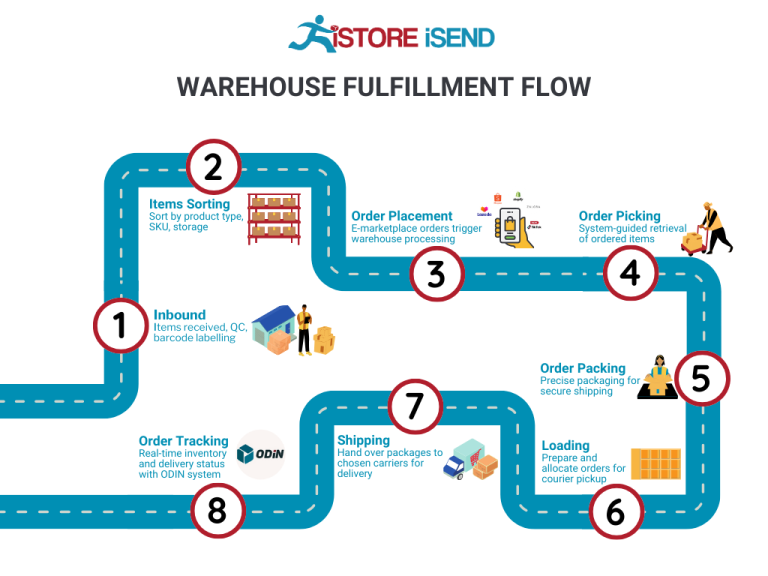
This step is vital for protecting the items during transit and ensuring customer satisfaction upon delivery. Proper packing reduces the risk of damage, which can lead to returns and increased costs. Additionally, employing smart packing techniques, such as using the right-sized box and eco-friendly materials, can reduce shipping costs and align with sustainability goals. This attention to detail can enhance brand reputation and customer loyalty.
5. Shipping & Delivery
The final step in the order fulfillment process is shipping and delivery. Once packed, orders are labeled and handed over to carriers for delivery. Amazon Fulfillment Center MDW7 utilizes a variety of shipping methods to ensure that packages reach customers quickly, often leveraging Amazon’s extensive logistics network for last-mile delivery.
The importance of this step is clear: timely delivery is a key driver of customer satisfaction in e-commerce. With options like same-day or next-day delivery, businesses that can fulfill orders quickly stand out in a competitive market. Advanced tracking systems provide customers with real-time updates on their order status, further enhancing the shopping experience. Additionally, understanding shipping costs and optimizing routes can lead to significant savings and improved efficiency in logistics operations.
In summary, understanding and optimizing each step in the order fulfillment process—from receiving inventory to shipping and delivery—can significantly enhance operational efficiency and customer satisfaction for e-commerce businesses. By investing in technology and best practices at each stage, businesses can scale effectively and meet the growing demands of their customers.
Comparing Fulfillment Models: In-House vs. 3PL vs. Dropshipping
Fulfillment Model Comparison
| Model | Who Handles Inventory | Best For (Business Stage) | Key Advantage | Key Disadvantage |
|---|---|---|---|---|
| In-House Fulfillment | The business itself | Established businesses with stable demand | Complete control over inventory and processes | Higher overhead costs and resource-intensive |
| Third-Party Logistics (3PL) | A third-party logistics provider | Growing businesses looking to scale | Flexibility and access to logistics expertise | Less control over inventory and processes |
| Dropshipping | The supplier | Startups and small businesses | Low upfront investment and no inventory risk | Lower profit margins and reliance on suppliers |
In-House Fulfillment
In-house fulfillment refers to the process where businesses manage their own warehousing, inventory, and shipping operations. This model is most suitable for established businesses that have a stable demand and sufficient resources to handle logistics. The primary advantage of in-house fulfillment is the complete control it offers over the inventory and fulfillment processes. Businesses can implement tailored processes that align with their brand standards, manage quality assurance effectively, and maintain direct oversight of their operations. However, this model comes with significant overhead costs, including staffing, warehousing, equipment, and technology investments. Additionally, the resource-intensive nature of in-house fulfillment can strain a company’s operational capacity, especially during peak seasons, making scalability a challenge.
Third-Party Logistics (3PL)
Third-party logistics (3PL) involves outsourcing logistics services to a specialized provider. This model is ideal for growing businesses that seek to scale efficiently without the burden of managing logistics operations themselves. 3PL providers can offer a range of services, including warehousing, inventory management, order fulfillment, and shipping, often leveraging their expertise and technology to optimize supply chain processes. The key advantage of using a 3PL is the flexibility it provides; businesses can scale operations up or down based on demand, access advanced logistics technology without heavy investment, and benefit from the provider’s network and industry knowledge. However, a notable disadvantage is the reduced control over inventory and fulfillment processes, which can impact customer experience if the 3PL does not meet service expectations. Businesses must also ensure they partner with a reliable 3PL provider to maintain quality and efficiency.
Dropshipping
Dropshipping is a fulfillment model where the retailer does not keep the products it sells in stock. Instead, when a retailer sells a product, it purchases the item from a third-party supplier, who then ships it directly to the customer. This model is particularly attractive for startups and small businesses, as it requires minimal upfront investment and eliminates the need to manage inventory. The key advantage of dropshipping is the low financial risk associated with holding unsold inventory, allowing businesses to offer a wider range of products without the associated costs of warehousing and logistics. However, dropshipping also comes with challenges, including lower profit margins due to reliance on suppliers and potential delays in shipping, which can affect customer satisfaction. Additionally, businesses must be cautious about the quality and reliability of their suppliers, as they directly impact the customer experience and brand reputation.
In summary, each fulfillment model presents unique benefits and challenges. Businesses should carefully assess their operational capabilities, growth objectives, and customer expectations when choosing a fulfillment strategy. By understanding the nuances of in-house fulfillment, 3PL, and dropshipping, e-commerce business owners can make informed decisions that align with their long-term goals and operational needs.
A Deep Dive into Amazon FBA: Pros, Cons, and Who It’s For
What is Fulfillment by Amazon (FBA)?
Fulfillment by Amazon (FBA) is a service offered by Amazon that allows e-commerce sellers to store their products in Amazon’s fulfillment centers. Amazon takes care of storage, packaging, and shipping of these products to customers. Sellers simply need to manage their inventory and listings, while Amazon handles the logistics and customer service. This service is particularly appealing to businesses looking to scale their operations without the hassle of managing their own warehouses or logistics.
When a customer places an order for a product listed through FBA, Amazon picks, packs, and ships the item directly from its fulfillment center. Additionally, FBA products are eligible for Amazon Prime, which can significantly enhance visibility and sales potential for sellers. The integration of FBA into your business can streamline operations and provide a more professional appearance to your customers.
How Does FBA Work?
-
Setting Up FBA: Sellers must create an Amazon seller account and enroll in the FBA program. After that, they prepare their products according to Amazon’s guidelines and ship them to Amazon’s fulfillment centers.
-
Storage and Inventory Management: Once the products arrive at the fulfillment center, Amazon takes care of storage. Sellers can track their inventory levels through the Amazon Seller Central dashboard.
-
Order Fulfillment: When an order is placed, Amazon automatically fulfills it by picking the item from the warehouse, packing it, and shipping it to the customer. Sellers do not need to handle any of these steps.
-
Customer Service and Returns: Amazon manages all customer service inquiries and returns for FBA orders. This means that sellers can focus more on their core business activities rather than dealing with customer service issues.
-
Payment: After the order is fulfilled, Amazon deposits the sale proceeds into the seller’s account, minus the FBA fees.
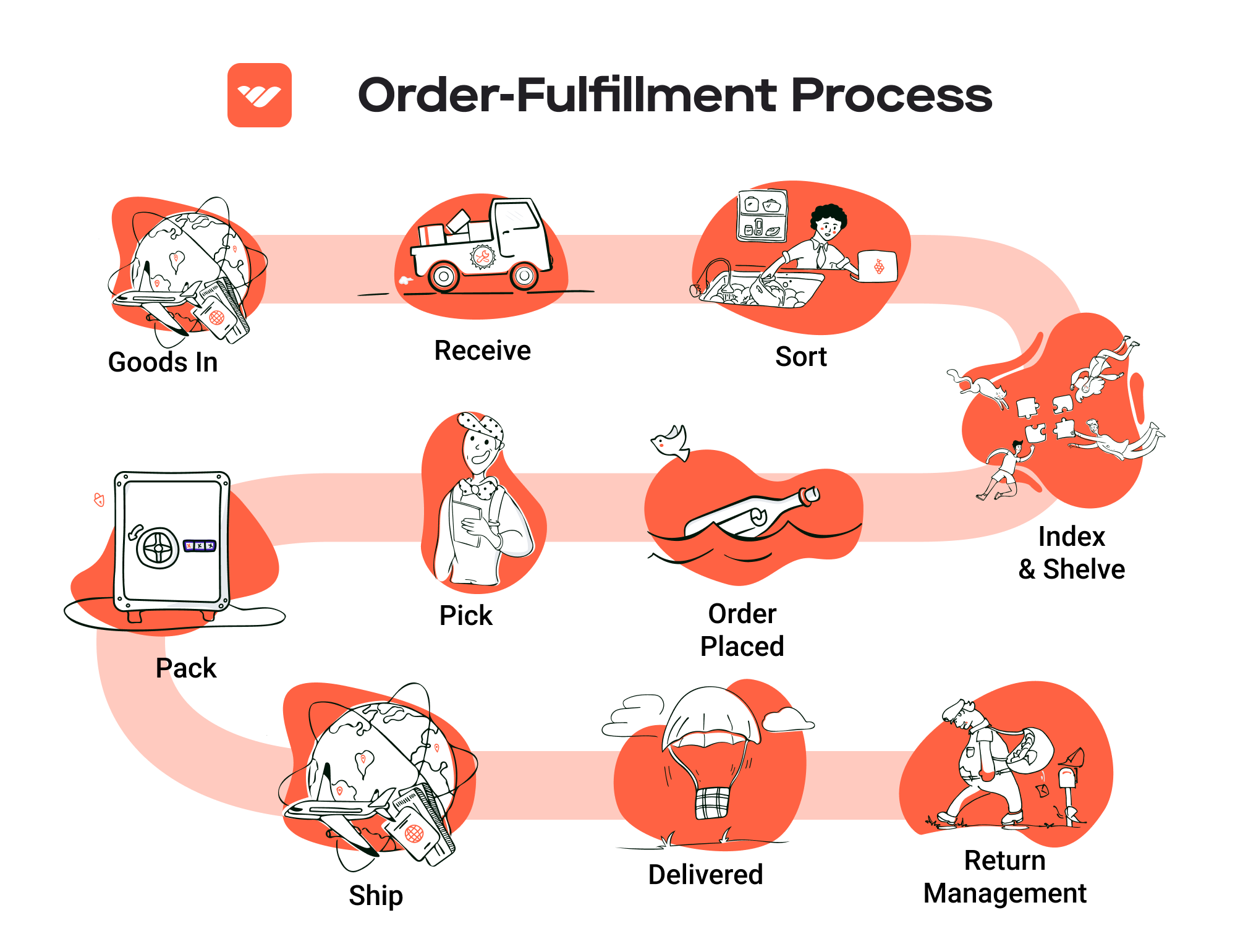
Pros of Using FBA
1. Prime Eligibility
FBA products are eligible for Amazon Prime, which can attract a large customer base that prefers fast, free shipping. Prime members are more likely to purchase items that qualify for their membership, potentially increasing sales for FBA sellers.
2. Customer Trust
Amazon is a trusted name in e-commerce. By using FBA, sellers can leverage Amazon’s reputation for reliability, which can enhance customer confidence in their products. This trust can lead to higher conversion rates and repeat purchases.
3. Multi-Channel Fulfillment
FBA can be used to fulfill orders from other sales channels, such as eBay or a seller’s own website. This allows businesses to centralize their logistics and inventory management, making it easier to manage their overall operations.
4. Streamlined Operations
Outsourcing logistics to Amazon allows sellers to focus on their core business activities, such as marketing and product development. Amazon’s advanced technology and infrastructure enable efficient order processing and delivery.
5. Advanced Logistics
Amazon’s fulfillment centers utilize advanced technologies, including robotics and AI, to optimize inventory management and order fulfillment. This can lead to faster processing times and reduced errors, benefiting sellers and customers alike.
Cons of Using FBA
1. High Fees
FBA comes with various fees, including storage fees for inventory and fulfillment fees for each order shipped. These costs can accumulate and impact profit margins, especially for low-priced items or slow-moving inventory.
2. Strict Inventory Rules
Sellers must adhere to strict guidelines regarding inventory management, including labeling requirements and maximum storage limits. Failure to comply can result in additional fees or penalties.
3. Commingling Risks
FBA products may be commingled with inventory from other sellers, which can lead to issues if a defective or subpar product is shipped to a customer. This risk can tarnish a seller’s reputation and lead to negative reviews.
4. Loss of Control
When using FBA, sellers relinquish some control over the fulfillment process. This includes aspects like packaging and shipping, which may not align with the seller’s branding or customer service expectations.
5. Limited Customization
Sellers have limited options for customizing packaging and shipping methods. For businesses that pride themselves on unique branding experiences, this can be a significant drawback.
Who is FBA Best For?
Fulfillment by Amazon is particularly beneficial for:
-
Small to Medium-Sized Businesses: Companies that lack the resources or infrastructure to manage their own logistics can benefit greatly from FBA’s streamlined operations.
-
E-commerce Entrepreneurs: New sellers looking to enter the market without the complexities of logistics management will find FBA an attractive option.
-
Sellers with High Volume Sales: Businesses that anticipate high sales volumes can leverage FBA to scale operations quickly and efficiently.
-
Brands with Seasonal Products: For sellers with seasonal or fluctuating demand, FBA can help manage inventory during peak times without the need for long-term storage solutions.
-
Multi-Channel Sellers: Businesses selling on multiple platforms can use FBA to simplify their fulfillment processes and maintain a consistent customer experience.
In conclusion, while Fulfillment by Amazon offers numerous advantages, such as increased visibility and streamlined logistics, it also comes with challenges that sellers must consider. Evaluating your business model, sales volume, and operational needs will help determine if FBA is the right fit for your e-commerce strategy.
Core Services Offered by Fulfillment Centers
Inventory Management & Warehousing
Inventory management and warehousing are foundational services provided by fulfillment centers, essential for e-commerce businesses aiming to scale effectively. Fulfillment centers like Amazon’s MDW7 in Monee, IL, offer sophisticated inventory management systems that track stock levels, manage SKU variations, and forecast demand. By utilizing advanced technology, such as RFID and barcoding, these centers ensure that inventory is accurately tracked in real-time.
The benefits of this service are manifold. First, it minimizes the risk of stockouts or overstock situations, which can lead to lost sales or increased holding costs, respectively. Efficient inventory management enables businesses to maintain optimal stock levels, ensuring that products are available when customers want them. Furthermore, centralized warehousing allows for economies of scale, reducing overall storage costs and improving cash flow. This is particularly crucial for e-commerce businesses that operate on tight margins and need to optimize every aspect of their operations.
Pick and Pack Services
Pick and pack services are a critical component of the fulfillment process, directly impacting order accuracy and delivery speed. In this service, fulfillment center staff are responsible for retrieving products from the warehouse (picking) and then packaging them for shipment (packing). At MDW7, this process is streamlined through the use of automated systems and trained personnel, which helps to ensure that orders are fulfilled correctly and efficiently.
The primary advantage of pick and pack services is the enhancement of order fulfillment speed and accuracy. In an era where consumers expect rapid delivery, the ability to quickly pick and pack orders can significantly enhance customer satisfaction. Moreover, accurate order fulfillment reduces the likelihood of returns and exchanges, which can be costly for e-commerce businesses. By outsourcing these operations to a specialized fulfillment center, businesses can focus on their core activities, such as product development and marketing, while ensuring that their logistics are handled by experts.
Kitting and Assembly
Kitting and assembly services involve the grouping of individual items into ready-to-ship sets or kits. This is particularly useful for businesses that offer bundled products, promotional sets, or customized orders. Fulfillment centers like MDW7 provide these services to help streamline the production and shipping processes. By assembling products before they are shipped, businesses can save time and reduce labor costs associated with individual order processing.
The benefits of kitting and assembly services are significant for e-commerce businesses. This service allows companies to create unique product offerings that can enhance their competitive edge in the market. It also simplifies inventory management, as businesses can track bundled products as single units rather than multiple individual items. Additionally, kitting can lead to increased sales, as bundled offerings often provide perceived value to customers, encouraging larger purchases. By utilizing these services, businesses can enhance their operational efficiency while also improving customer satisfaction through well-packaged and thoughtfully curated products.
Returns Management (Reverse Logistics)
Returns management, or reverse logistics, is an essential service offered by fulfillment centers that addresses the complexities of product returns. In an e-commerce environment, where return rates can be significantly higher than traditional retail, having an efficient returns management process is crucial. Fulfillment centers like MDW7 facilitate the return process by providing businesses with the infrastructure to handle returns effectively, including inspection, restocking, and refund processing.
The benefits of a robust returns management system are substantial. First, it enhances customer trust and satisfaction by providing a hassle-free return experience. This is vital in an e-commerce setting, where consumers may be hesitant to make purchases without a clear and easy return policy. Additionally, an efficient returns process can minimize the costs associated with returns, allowing businesses to recover value from returned items through resale or refurbishing. Implementing a streamlined returns management system can also provide valuable data insights into product performance and customer preferences, enabling businesses to make informed decisions about inventory and product offerings.
In summary, the core services offered by fulfillment centers are designed to optimize the logistics processes for e-commerce businesses. By leveraging inventory management, pick and pack services, kitting and assembly, and returns management, businesses can enhance their operational efficiency, improve customer satisfaction, and ultimately drive growth. As e-commerce continues to evolve, partnering with a capable fulfillment center like MDW7 can provide a strategic advantage in navigating the complexities of modern logistics.
How to Choose a Fulfillment Partner: A 6-Point Checklist
Location & Warehouse Network
When selecting a fulfillment partner, the location of their warehouses is critical. A strategically positioned warehouse can significantly reduce shipping times and costs, which is essential for maintaining customer satisfaction in e-commerce.
Why It’s Important:
Proximity to your target market can lead to faster delivery times, which enhances customer experience and potentially reduces shipping expenses. Additionally, a robust network of warehouses can provide flexibility in distribution strategies.
Questions to Ask:
– What is the location of your warehouses, and how do they align with my target customer demographics?
– Can you provide information about your shipping zones and average delivery times?
– Do you have a network of warehouses that can support my expansion into new regions?
Technology & Integrations
In today’s e-commerce landscape, technology plays a vital role in efficient order fulfillment. Your fulfillment partner should offer systems that integrate seamlessly with your existing platforms.
Why It’s Important:
Advanced technology can streamline operations, from inventory management to order tracking. Integration capabilities with your e-commerce platform (like Amazon, Shopify, etc.) are crucial for real-time updates and efficient data management.
Questions to Ask:
– What order management system (OMS) do you use, and how does it integrate with my e-commerce platform?
– Can you provide real-time inventory tracking and reporting?
– What technology do you use for shipping and logistics, and how does it enhance efficiency?
Specializations (e.g., Cold Storage, Oversized Items)
Different businesses have unique requirements based on their product types. Ensure your potential partner can handle your specific needs, whether that involves cold storage for perishables or special handling for oversized items.
Why It’s Important:
Choosing a partner with the right specializations can prevent damage to products and ensure compliance with regulations (especially important for food and pharmaceuticals). This can also impact your ability to serve specific markets.
Questions to Ask:
– Do you have specialized storage capabilities for my product type (e.g., temperature-controlled storage, hazardous materials)?
– What experience do you have in handling products similar to mine?
– Can you accommodate seasonal fluctuations in inventory?
Scalability & Capacity
As your business grows, so will your fulfillment needs. Your partner should be able to scale operations in line with your growth trajectory.
Why It’s Important:
A partner that can quickly adapt to changes in order volume or product offerings can save you from costly disruptions. Scalability ensures that you can expand into new markets or manage seasonal spikes without changing partners.
Questions to Ask:
– What is your current capacity, and how do you handle peak seasons or unexpected surges in demand?
– Can you provide examples of how you have scaled for other clients?
– What are your plans for future expansions or enhancements in capacity?
Pricing and Contracts
Understanding the pricing structure and contractual obligations is crucial for budgeting and long-term planning. Transparent pricing can prevent surprises down the line.
Why It’s Important:
Unclear pricing can lead to hidden costs that can erode your profit margins. A flexible contract can provide the assurance that you won’t be locked into unfavorable terms.
Questions to Ask:
– What is your pricing model (e.g., per order, monthly fees, volume discounts)?
– Are there any additional fees I should be aware of (e.g., storage, pick and pack fees)?
– What are the terms for contract cancellation or modifications?
Customer Support & Reviews
Effective customer support is essential for resolving issues quickly and maintaining smooth operations. Additionally, reviews and testimonials can provide insight into a partner’s reliability and service quality.
Why It’s Important:
Strong customer support can mitigate issues before they escalate and ensure that your operations run smoothly. Reviews from other clients can give you a sense of what to expect in terms of service and reliability.
Questions to Ask:
– What customer support options do you offer (e.g., phone, email, live chat)?
– Can you provide references or case studies from similar businesses?
– How do you handle issues or disputes that arise during the fulfillment process?
Conclusion
Choosing the right fulfillment partner is a critical decision that can impact your e-commerce business’s efficiency, customer satisfaction, and ultimately, your bottom line. By carefully evaluating these six key areas—location, technology, specializations, scalability, pricing, and customer support—you can make an informed decision that aligns with your business goals and growth plans.
Understanding Fulfillment Pricing: A Breakdown of Common Fees
Initial Setup Fees
When partnering with a fulfillment center like Amazon’s MDW7, the initial setup fees typically encompass the costs associated with onboarding your products into the system. This may include the creation of your seller account, product listing setup, and any necessary training on how to use the fulfillment platform.
The calculation for initial setup fees can vary significantly depending on the complexity of your business model and the fulfillment service provider. For example, if you have a large catalog of products, the setup process may require more time and resources, resulting in higher fees. Conversely, businesses with a smaller number of SKUs may incur lower initial costs. It’s essential to inquire about any potential discounts for bulk setups or promotions that may be available.
Receiving Fees
Receiving fees are charged when inventory is delivered to the fulfillment center. These fees cover the labor and resources needed to unload, inspect, and store your products.
Typically, these fees are calculated based on the volume of goods received, often measured in weight (pounds or kilograms) or the number of pallets delivered. For instance, a fulfillment center might charge a set fee for each pallet received, plus an additional charge per item if the shipment includes a large number of individual products.
Understanding this fee structure is crucial, as it can impact your overall logistics costs, especially if you frequently replenish inventory. To minimize receiving fees, consider consolidating shipments and ensuring that your products are packaged efficiently.
Storage Fees (per pallet/bin)
Storage fees are incurred for keeping your inventory in the fulfillment center. These fees can vary based on the storage method used—whether by pallet, bin, or other measures—and are typically charged on a monthly basis.
The calculation for storage fees is usually straightforward: you’ll pay a specific amount for each pallet or bin occupied. For example, a fulfillment center might charge $20 per pallet per month. However, some centers may offer tiered pricing based on the volume of storage used, providing discounts for higher quantities.
To manage storage costs effectively, regularly review your inventory turnover rates. If certain products are not selling as quickly, consider implementing strategies to reduce excess stock, such as promotional campaigns or bundling products.
Pick & Pack Fees (per item/order)
Pick and pack fees are charged for the labor involved in retrieving items from storage and preparing them for shipment. This includes picking the items, packing them securely, and labeling them for delivery.
These fees are typically calculated on a per-item or per-order basis. For instance, a fulfillment center may charge $1.50 per item picked and packed, or a flat fee of $3.00 per order regardless of the number of items. It’s important to understand that the more items in an order, the higher the total pick and pack fee will be.
To optimize these costs, consider streamlining your product offerings and encouraging larger orders through incentives. This can help reduce the frequency of orders and, subsequently, the total pick and pack fees.
Shipping Fees
Shipping fees are one of the most significant costs associated with fulfillment services. These fees cover the transportation of your products from the fulfillment center to your customers.
Shipping fees can vary based on several factors, including the shipping method chosen (standard, expedited, etc.), package weight, dimensions, and the destination. Many fulfillment centers offer discounted shipping rates due to their volume, which can be beneficial for your business.
To calculate your shipping fees accurately, consider using shipping calculators provided by fulfillment centers or third-party logistics companies. Additionally, leveraging flat-rate shipping options when feasible can help control costs.
Tips for Getting an Accurate Quote
-
Provide Detailed Information: When requesting a quote, ensure you provide comprehensive information about your products, including dimensions, weights, and estimated order volumes.
-
Understand Your Needs: Clearly outline your specific fulfillment requirements, such as storage needs, anticipated order frequency, and shipping preferences.
-
Ask About Discounts: Inquire about any available discounts for volume shipping, long-term contracts, or seasonal promotions, as these can significantly impact overall costs.
-
Review Terms and Conditions: Carefully read the fulfillment center’s terms and conditions to understand all potential fees and charges associated with their services.
-
Get Multiple Quotes: Compare quotes from different fulfillment centers to find the best fit for your business needs and budget.
By understanding these common fulfillment pricing models and taking proactive steps to manage costs, you can optimize your logistics strategy and scale your e-commerce operations effectively.
Frequently Asked Questions (FAQs) about Fulfillment
1. What is the Amazon Fulfillment Center MDW7 located in Monee, IL?
The Amazon Fulfillment Center MDW7 is a large-scale facility situated at 6521 W Monee Manhattan Rd, Monee, IL 60449. It specializes in storing, packing, and shipping a diverse range of products for Amazon, playing a crucial role in the company’s logistics and distribution network. The center utilizes advanced technology to manage a high volume of orders efficiently and accurately.
2. How does the fulfillment process work at MDW7?
At MDW7, the fulfillment process involves receiving products, storing them in an organized manner, picking items based on customer orders, packing them securely, and shipping them out to customers. The facility employs sophisticated robotics and automation to streamline these operations, ensuring timely and accurate deliveries.
3. What types of products are stored at the MDW7 Fulfillment Center?
MDW7 stores a wide variety of products, including electronics, fashion items, home goods, toys, beauty products, and everyday essentials. This diverse inventory allows Amazon to cater to a broad customer base, providing quick access to a wide selection of items.
4. What’s the difference between a warehouse and a fulfillment center?
A warehouse primarily focuses on storing goods, while a fulfillment center is designed to handle the complete order processing cycle, including receiving, storing, picking, packing, and shipping products directly to customers. Fulfillment centers emphasize speed and efficiency in the distribution process to meet customer demand.
5. What is a 3PL (Third-Party Logistics)?
A 3PL, or third-party logistics provider, is a service that allows businesses to outsource their logistics and supply chain management. This includes warehousing, transportation, inventory management, and order fulfillment. Using a 3PL can help businesses scale operations without the overhead of managing their own logistics infrastructure.
6. How much do fulfillment services cost?
The cost of fulfillment services varies based on factors such as order volume, storage requirements, and specific services offered (e.g., picking, packing, shipping). On average, fulfillment costs can range from $2 to $5 per order, plus storage fees that can vary depending on the size and quantity of inventory stored.
7. How does Amazon ensure order accuracy at MDW7?
Amazon employs advanced technology, including barcode scanning and robotics, to ensure order accuracy. Each product is scanned during the picking and packing processes, reducing the likelihood of errors. Additionally, quality control measures are in place to verify that the correct items are shipped.
8. Can businesses use MDW7 for their own products?
Yes, businesses can leverage Amazon’s fulfillment services through the Fulfillment by Amazon (FBA) program. This allows sellers to store their products in Amazon’s fulfillment centers, including MDW7, and benefit from Amazon’s logistics capabilities for order fulfillment.
9. What are the benefits of using Amazon Fulfillment Center MDW7?
Using MDW7 offers several benefits, including access to Amazon’s vast logistics network, fast and reliable shipping options, and the ability to scale operations without heavy investments in infrastructure. Additionally, businesses can take advantage of Amazon’s customer service and return management processes.
10. How can I get more information or a tour of the MDW7 Fulfillment Center?
For more information about the MDW7 Fulfillment Center or to book a tour, you can visit Amazon’s official website or the Amazon Tours page. Tours typically last 60-90 minutes and provide insights into the fulfillment process and technology used at the facility. It is advisable to book in advance as spots may fill quickly.
Conclusion: Is Outsourcing Fulfillment the Right Move for Your Business?
The Strategic Advantage of Outsourcing Fulfillment
Outsourcing fulfillment can be a transformative move for e-commerce businesses aiming for growth and efficiency. By leveraging a fulfillment service, you can save significant time—time that can be redirected toward strategic initiatives such as marketing and product development. Fulfillment centers, such as Amazon’s MDW7 facility, are designed to handle vast volumes of orders with speed and precision, allowing you to meet customer demands promptly and effectively.
Scalability is another compelling benefit. As your business grows, your fulfillment needs will likely evolve. A dedicated fulfillment partner can seamlessly scale operations to match your increasing order volume without the headaches of managing additional warehousing, staffing, or logistics complexities. This flexibility not only supports your growth trajectory but also ensures that you can adapt to market fluctuations and seasonal demands without losing efficiency.
Moreover, outsourcing to a specialized fulfillment service provides access to expertise that might not be available in-house. These partners invest in advanced technology and processes, ensuring that your logistics operations are optimized for accuracy and reliability. With their experience, they can help you navigate the complexities of inventory management, shipping regulations, and customer service, allowing you to focus on core business functions.
However, the choice of a fulfillment partner is critical. Conducting thorough due diligence is essential to ensure alignment with your business values and operational needs. Evaluate potential partners not only on cost but also on their technology, reliability, and customer service capabilities.
To determine if outsourcing fulfillment is the right next step for your business, conduct an audit of your current shipping processes. Assess areas for improvement, potential cost savings, and how a fulfillment partner could enhance your overall service delivery. This strategic reflection could pave the way for a more efficient and scalable operation, setting the stage for sustainable growth.
Important Disclaimer
⚠️ Important Disclaimer
The information in this guide is for educational purposes. Fulfillment services, pricing, and platform features change frequently. Always conduct your own due diligence and consult with providers directly before making business decisions.

